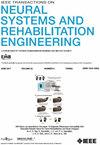XCF-LSTMSATNet: A Classification Approach for EEG Signals Evoked by Dynamic Random Dot Stereograms
IF 4.8
2区 医学
Q2 ENGINEERING, BIOMEDICAL
IEEE Transactions on Neural Systems and Rehabilitation Engineering
Pub Date : 2025-01-16
DOI:10.1109/TNSRE.2025.3529991
引用次数: 0
Abstract
Stereovision is the visual perception of depth derived from the integration of two slightly different images from each eye, enabling understanding of the three-dimensional space. This capability is deeply intertwined with cognitive brain functions. To explore the impact of stereograms with varied motions on brain activities, we collected Electroencephalography (EEG) signals evoked by Dynamic Random Dot Stereograms (DRDS). To effectively classify the EEG signals induced by DRDS, we introduced a novel hybrid neural network model, XCF-LSTMSATNet, which integrates an XGBoost Channel Feature Optimization Module with the EEGNet and an LSTM Self-Attention Modules. Initially, in the channel selection phase, XGBoost is employed for preliminary classification and feature weight analysis, which can enhance our channel selection strategy. Following this, EEGNet employs deep convolutional layers to extract spatial features, while separable convolutions are subsequently used to derive high-dimensional spatial-temporal features. Meanwhile, the LSTMSAT Module, with its capability to learn long-term dependencies in time-series signals, is deployed to capture temporal continuity information. The incorporation of the self-attention mechanism further amplifies the model’s ability to grasp long-distance dependencies and enables dynamic weight allocation to the extracted features. In the end, both temporal and spatial features are integrated into the classification module, enabling precise prediction across three categories of EEG signals. The proposed XCF-LSTMSATNet was extensively tested on both a custom dataset and the public datasets SRDA and SRDB. The results demonstrate that the model exhibits solid classification performance across all three datasets, effectively showcasing its robustness and generalization capabilities.XCF-LSTMSATNet:动态随机点立体图诱发的脑电信号分类方法
立体视觉是通过整合每只眼睛的两幅略有不同的图像而产生的深度视觉感知,从而实现对三维空间的理解。这种能力与大脑的认知功能密切相关。为了探索不同运动的立体图对大脑活动的影响,我们收集了动态随机点立体图(DRDS)诱发的脑电图(EEG)信号。为了对 DRDS 诱导的脑电信号进行有效分类,我们引入了一种新型混合神经网络模型 XCF-LSTMSATNet,该模型将 XGBoost 信道特征优化模块与 EEGNet 和 LSTM 自注意模块集成在一起。首先,在信道选择阶段,XGBoost 用于初步分类和特征权重分析,这可以增强我们的信道选择策略。随后,EEGNet 采用深度卷积层提取空间特征,而可分离卷积则用于提取高维时空特征。同时,LSTMSAT 模块具有学习时间序列信号中长期依赖关系的能力,可用于捕捉时间连续性信息。自我关注机制的加入进一步增强了模型把握长距离依赖关系的能力,并实现了对提取特征的动态权重分配。最后,时间和空间特征都被集成到分类模块中,从而实现了对三类脑电信号的精确预测。对所提出的 XCF-LSTMSATNet 在定制数据集和公共数据集 SRDA 和 SRDB 上进行了广泛测试。结果表明,该模型在所有三个数据集上都表现出了良好的分类性能,有效地展示了其鲁棒性和泛化能力。
本文章由计算机程序翻译,如有差异,请以英文原文为准。
求助全文
约1分钟内获得全文
求助全文
来源期刊
CiteScore
8.60
自引率
8.20%
发文量
479
审稿时长
6-12 weeks
期刊介绍:
Rehabilitative and neural aspects of biomedical engineering, including functional electrical stimulation, acoustic dynamics, human performance measurement and analysis, nerve stimulation, electromyography, motor control and stimulation; and hardware and software applications for rehabilitation engineering and assistive devices.

 求助内容:
求助内容: 应助结果提醒方式:
应助结果提醒方式:


